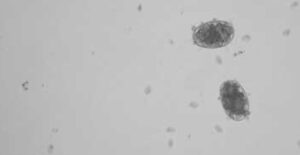Emerging Canine Hookworm Resistance
EMERGING CANINE HOOKWORM RESISTANCE
The canine hookworm, Ancylostoma caninum, is the most prevalent and important intestinal nematode parasite of dogs in the United States. This parasite uses teeth to attach to the intestinal mucosa and submucosa to feed on host blood. Clinical signs of infection include hematochezia, melena, anemia, hypoalbuminemia and weight loss. In some cases, adult infected dogs may not have any obvious signs of disease, (subclinically infected). Puppies with small numbers of hookworms also may not have obvious signs of disease. Puppies with a heavy worm infection may be very ill, with anemia (due to blood loss), diarrhea and failure to thrive. Heavy worm burdens can cause death in both young and old animals. Typically, hookworm infection is well controlled by treatment with approved drugs, and regular anthelmintic treatment is advocated as a preventative health measure. However, in recent years, recurrent and persistent hookworm infections have been observed and appear to be increasing.
Several recent studies have confirmed multiple drug resistance (MDR) against all antihelmintic drugs approved for treatment in the U.S., both in livestock and dogs. Anthelmintic resistance is defined as a heritable genetic change that enables a greater population of parasites to survive treatment at a dose previously effective.

Strongylid nematodes are especially adept at developing this genetic diversity. This has led to long standing resistance in livestock, but cases have begun to emerge on the canine population. Persistent cases of A. caninum infection can be caused by either larval leak (arrested larvae in somatic tissues continuously migrate to the small intestine, where they develop to the adult stage) or true drug resistance. It is important to distinguish between these situations to optimally manage each patient. Dogs with larval leak typically shed hookworm eggs in small numbers, with treatment only yielding a temporary interruption in egg shedding due to newly reactivated larvae repopulating the gut. In contrast, when worms are MDR, treatments fail to interrupt egg shedding. A quantitative fecal egg count (FEC) is the definitive means to assess for true resistance. If this fecal egg count reduction test (FECRT) is not available, at least performing both pretreatment and 14-day post-treatment fecal examinations are advised.

However, to add confusion is the ability of the hookworm to modulate their individual egg count proportionate to the intestinal population density. The original drug resistance in hookworms likely developed first through the misuse of anthelmintics in livestock. Evidence suggests the problem in dogs originated from racing greyhound breeding farms and kennels. The epidemiology of nematode transmission on greyhound farms is similar to that seen on livestock farms.
Ancylostoma caninum is the most common nematode parasite of greyhounds on breeding farms. These dogs are subject to very intense deworming protocols, presenting a very high degree of drug selection pressure on the hookworm population. In addition, the environment on these farms is ideal for larval development and transmission. It is likely most, if not all, actively racing and recently adopted greyhound dogs are infected with MDR hookworms. However, the preventative routine use of antiparasitic drugs cannot be excluded as a contribution to this dilemma in the general dog population.
CONCLUSION

Multiple Anthelmintic Resistance is a documented and emerging problem in dogs in the United States and therefore, veterinarians should watch for persistent infections. The problem appears to have originated in greyhound racing kennels and has spread to the general canine population. The emergence of MDR hookworms is a serious threat to canine health and necessitates a change in how clinicians manage persistent hookworm cases. The need for routine and post treatment fecal examinations in dogs is essential to determine if hookworm resistance is developing in your patient population.
Beyond the concern for canine health, MDR in canine hookworms could present a serious threat to human health, since this parasite is zoonotic. Markers for genetic resistance have already been noted in some human populations of Ancylostoma.
REFERENCES
- Jiminez Castro PD, Howell SB, Schaefer JJ, et al. Multiple Drug Resistance in the canine hookworm Ancylostoma caninum: an emerging threat? Parasite Vectors 2019; 12: 1-15.
- Jiminez Castro PD, Mansour A, Charles S et al. Efficacy evaluation of anthelmintic products against an infection with canine hookworm (Ancylostoma caninum) isolate Worthy 4.1F3P in dogs. IJP: Drugs and Resistance 2020; 13: 22-27.
- Jiminez Castro PD and Kaplan RM. Persistent or Suspected-Resistant Hookworm infections. Clinicansbrief August 2020;61-67.
- Jiminez Castro PD and Kaplan RM. Multiple-Anthelmintic Resistance in the Canine Hookworm Clinicansbrief April 2020;15-17.
- Kopp SR, Kotze AC, McCarthy JS and Coleman GT. High-level pyrantel resistance in the hookworm Ancylostoma caninum. Veterinary Parasitology 2007;143:299-304.
